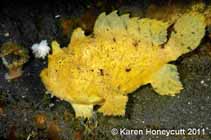| Family: |
Antennariidae (Frogfishes) |
| Max. size: |
20 cm TL (male/unsexed) |
| Environment: |
reef-associated; marine; depth range 0 - 90 m |
| Distribution: |
Indo-West Pacific: East Africa, India, and Malaysia to the Moluccas, north to Taiwan, south to northern Australia. Single record from Fiji. Appears to be absent from oceanic islands of the Indian Ocean. |
| Diagnosis: |
Dorsal spines (total): 3-3; Dorsal soft rays (total): 13-13; Anal spines: 0-0; Anal soft rays: 7-7. First dorsal spine about the same length as the 2nd dorsal spine, with a large tuff of filaments. Ground color of head and body light-tan with narrow blackish brown streaks. All fins with blackish-brown spots. Illicium longer than next dorsal fin ray with small rounded to elongate esca (Ref. 48635). Attains 45 cm SL.
Description: Characterized by having unbranched pelvic rays except posterior most; curved second and third dorsal spine; third dorsal spine membrane not reaching base of dorsal (Ref. 90102). |
| Biology: |
Inhabits still muddy habitats that are either deep or offshore (Ref. 48635) or shallow rocky and coral reefs (Ref. 9710). Oviparous. Eggs are bound in ribbon-like sheath or mass of gelatinous mucus called 'egg raft' or 'veil' (Ref. 6773). Minimum depth reported taken from Ref. 57178. Solitary and often among leaf-eater debris (Ref 90102). |
| IUCN Red List Status: |
Least Concern (LC); Date assessed: 06 September 2021 Ref. (130435)
|
| Threat to humans: |
harmless |
| Country info: |
|
Source and more info: www.fishbase.org. For personal, classroom, and other internal use only. Not for publication.

